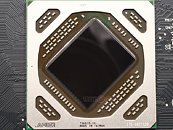Monday, May 4th 2015

AMD Radeon R9 380 Launched by PC OEM
Earlier this day, HP announced its newest line of desktop PCs, one of which comes with a curious-sounding Radeon R9 380 graphics card. HP's product pages for its new desktops aren't active, yet, leaving us to only speculate on what the R9 380 could be. One theory making rounds says that the R9 380 could either be a re-branded R9 285, or be based on its "Tonga" silicon, which physically features 2,048 stream processors based on Graphics CoreNext (GCN) 1.2 architecture, and a 384-bit wide GDDR5 memory interface. Another theory states that the R9 380 could be an OEM-only re-brand of the R9 280 or R9 280X, based on the 3+ year old "Tahiti" silicon.
The former theory sounds more plausible, because re-branding a "Tahiti" based product would be suicidal for AMD. Although based on GCN, "Tahiti" lacks a lot of architecture features introduced with "Hawaii" and "Tonga." AMD practically stopped optimizing games for "Tahiti," and some of its new features, such as FreeSync and XDMA CrossFire, can't be implemented on it. "Tonga," on the other hand, supports both these features, and one can create an SKU with all its 2,048 stream processors, and its full 384-bit GDDR5 memory interface unlocked. If the R9 380 is indeed an OEM-only product, then it's likely that the company's retail-channel products could be branded in the succeeding R9 400 series. GPU makers tend to re-brand and bump their SKUs by a series for OEMs to peddle in their "new" products at short notice.Our most recent understanding of AMD's next-gen lineup sees re-branding across the lineup, with just one genuinely new silicon. "Tonga" could drive the pair of SKUs that directly succeed the R9 270 and R9 270X; "Grenada," which is a refined version of "Hawaii," will drive the SKUs that succeed the R9 280 and R9 280X; while the new "Fiji" silicon, with its 4,096 stream processors and a fancy 640 GB/s HBM memory interface, could drive the SKUs that succeed R9 290 and R9 290X. An extraordinary rumor doing rounds is that one "Fiji" SKU could get a fancy model name à la NVIDIA Titan.
The former theory sounds more plausible, because re-branding a "Tahiti" based product would be suicidal for AMD. Although based on GCN, "Tahiti" lacks a lot of architecture features introduced with "Hawaii" and "Tonga." AMD practically stopped optimizing games for "Tahiti," and some of its new features, such as FreeSync and XDMA CrossFire, can't be implemented on it. "Tonga," on the other hand, supports both these features, and one can create an SKU with all its 2,048 stream processors, and its full 384-bit GDDR5 memory interface unlocked. If the R9 380 is indeed an OEM-only product, then it's likely that the company's retail-channel products could be branded in the succeeding R9 400 series. GPU makers tend to re-brand and bump their SKUs by a series for OEMs to peddle in their "new" products at short notice.Our most recent understanding of AMD's next-gen lineup sees re-branding across the lineup, with just one genuinely new silicon. "Tonga" could drive the pair of SKUs that directly succeed the R9 270 and R9 270X; "Grenada," which is a refined version of "Hawaii," will drive the SKUs that succeed the R9 280 and R9 280X; while the new "Fiji" silicon, with its 4,096 stream processors and a fancy 640 GB/s HBM memory interface, could drive the SKUs that succeed R9 290 and R9 290X. An extraordinary rumor doing rounds is that one "Fiji" SKU could get a fancy model name à la NVIDIA Titan.

32 Comments on AMD Radeon R9 380 Launched by PC OEM
That link points to this link which makes a pretty strong case that the R9 380 is all new. AMD has to clear its old inventory so the R9 3## (at least 380, 390, 390X) cards may be ready to ship already.
It's well documented and discussed that most contemporary 550W PSU's of acceptable quality are more than satisfactory with the bulk of R9 290's. If you check Guru3D's power supply recommendation for a R9 290 DirectCU II OC Edition which has 1000Mhz boost; he's indicating for the average system a 550~600 Watt PSU is acceptable.
Interestingly an OEM as HP would value price, power, heat/thermals, within that chassis build, while maintaining strong performance/value. This might leave one to reason a R9 380 as acceptable on power/heat and priced for HP to consider it even over the 970, or on par to what Nvidia was willing to provide though not at as an attractive price.
Although the flip side, AMD couldn't best the 980's thermal/power envelope, and HP is willing take Nvidia pricing of the 980 to provide the "utmost" that chassis/PSU can maintain.
Kepler was no more efficient than GCN (Even 1.0).
There needs to be a "standard" (aka CAFA mpg) that runs several titles over a 10 min loop and logged with high-level equipment. While Tom's employs a logging oscilloscope they seem to mess around with test computers configuration and testing parameters (title, time etc.), so the data isn’t organized to correlate results from other testing they do.
http://www.tomshardware.com/reviews/radeon-r9-290-and-290x,3728-4.html
The R9 series:
R9 380 is a straight up rebrand of the R9 285
R9 370 is a rebranded R7 265 (HD 7850) with a 50MHz clock increase
R9 360 is a rebranded R7 260 (HD 7790) with a 60MHz clock increase
The R7 series:
R7 350 is straight up rebrand of the R7 250
R7 340 is a R7 250 with a 270 MHz lower clock
The R5 series:
R5 340 is a R7 240 with a 45MHz clock increase
R5 330 is a R5 240 with a 75MHz clock increase